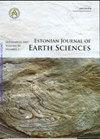非奥陶纪陆生植物的进化视角
IF 0.8
4区 地球科学
Q4 GEOSCIENCES, MULTIDISCIPLINARY
引用次数: 0
摘要
陆生植物(胚胎植物)起源的分子系统发育研究已经开始梳理出那些来自先前藻类基因的进化贡献,以及那些在绿叶植物-胚胎植物过渡过程中进化的新生基因。将植物进化中的基因组组装概念应用于化石记录,将导致奥陶纪陆地植物记录解释的范式转变。传统的系统发育思想要求化石物种分类群在系统发育中占据节点。进化-发展方法可以从物种分类群中分离出特征进化,释放出化石孢子和组织碎片,从而成为潜在发育途径或基因调控网络的线索。这导致了对奥陶纪景观中陆地植物存在的意义的重新评估。这个新模型有助于调和分子时间树和奥陶纪时期“缺失”的植物化石记录之间的差异。本文章由计算机程序翻译,如有差异,请以英文原文为准。
An evo-devo perspective on no Ordovician land plants
Molecular phylogenetic studies of land plant (embryophyte) origins have begun to tease apart those evolutionary contributions derived from prior algal genes and those de novo genes that evolved during a charophyte–embryophyte transition. Applying the concept of genomic assembly in plant evolution to the fossil record leads to a paradigm shift in the interpretation of the Ordovician record of land plants. Traditional phylogenetic thinking requires fossil species taxa to occupy nodes on a phylogeny. An evo-devo approach can view character evolution separately from species taxa, freeing up fossil spores and tissue fragments to become clues to underlying developmental pathways or gene regulatory networks. This results in a re-assess ment of what is meant by the presence of land plants in the Ordovician landscape. The new model helps to reconcile discrepancies between molecular time-trees and the “missing” record of fossil plants during the Ordovician Period.
求助全文
通过发布文献求助,成功后即可免费获取论文全文。
去求助
来源期刊

Estonian Journal of Earth Sciences
地学-地球科学综合
CiteScore
1.50
自引率
9.10%
发文量
11
审稿时长
>12 weeks
期刊介绍:
The Estonian Journal of Earth Sciences is an international scientific open access journal published by the Estonian Academy of Sciences in collaboration with the Tallinn University of Technology, the University of Tartu, the Estonian University of Life Sciences and the Talllinn University.
The journal publishes primary research and review papers in the English language. All articles are provided with short Estonian summaries.
All papers to be published in the journal are peer reviewed internationally.
The journal is open for publications in all fields of Earth sciences, including besides different geological sensu lato disciplines, also geography and oceanography having certain connection with our part of the world, North Europe and the Baltic area in particular.
 求助内容:
求助内容: 应助结果提醒方式:
应助结果提醒方式:


